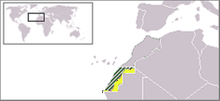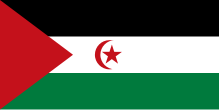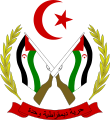Outline of the Sahrawi Arab Democratic Republic
The following outline is provided as an overview of and topical guide to the Sahrawi Arab Democratic Republic:

Sahrawi Arab Democratic Republic (SADR) – partially recognised state that claims sovereignty over the entire territory of Western Sahara, is a former Spanish colony. The SADR was proclaimed by the Polisario Front on February 27, 1976, in Bir Lehlou, Western Sahara. The SADR government controls about 20-25% of the territory it claims.[1] It calls the territories under its control the Liberated Territories or the Free Zone. Morocco controls and administers the rest of the disputed territory and calls this area its Southern Provinces. The United Nations and the SADR government considers the Moroccan-controlled territory to be an occupied territory.
General reference
edit- Pronunciation: /səˈrɑːwi/ sə-RAH-wee
- Common English country name: Western Sahara
- Official English country name: The Sahrawi Arab Democratic Republic
- Common endonyms
- Official endonym(s):
- Adjectival(s):
- Demonym(s):
- Etymology: Name of the Sahrawi Arab Democratic Republic
- ISO country codes: See the Outline of Western Sahara
- ISO region codes: See the Outline of Western Sahara
- Internet country code top-level domain: See the Outline of Western Sahara
Geography of the Sahrawi Arab Democratic Republic
editGeography of the Sahrawi Arab Democratic Republic
- Sahrawi Arab Democratic Republic is: a republic in exile, holding but a small portion of the territory they claim
- Location
- Sahrawi Arab Democratic Republic is situated within the following regions of the world:
- Territory claimed: Western Sahara
- Territory held: Free Zone
- Location of most of the citizens in exile: Sahrawi refugee camps (self-managed camps in Tindouf Province, Algeria)
- Time zone: Coordinated Universal Time UTC+00
- Atlas of the Sahrawi Arab Democratic Republic
Environment of Western Sahara
editEnvironment of Western Sahara
- Climate of Western Sahara
- Ecoregions in Western Sahara
- Wildlife of Western Sahara
- Fauna of Western Sahara
Natural geographic features of Western Sahara
editLandforms in Western Sahara
- Deserts in Western Sahara
- Glaciers in Western Sahara: none [2]
- World Heritage Sites in Western Sahara: None
Administrative divisions of the Sahrawi Arab Democratic Republic
edit- Free Zone – area that lies between the Moroccan Wall and the border with Algeria.
- Sahrawi refugee camps – self-managed camps in Tindouf Province, Algeria
- The SADR claims the rest of Western Sahara, but the portion west of the Moroccan Wall is occupied by Morocco.
- Provinces of Western Sahara
Municipalities of the Sahrawi Arab Democratic Republic
edit- Capital of the Sahrawi Arab Democratic Republic:
- Tifariti – temporary capital and headquarters of the Polisario Front
- El Aaiún (de jure) – headquarters of Moroccan occupation, but still considered by the SADR to be its true capital
- Towns within the Free Zone, administered by the Sahrawi Arab Democratic Republic
- Tifariti تيفاريتي – temporary capital and headquarters of the Polisario Front
- Bir Lehlou بير لحلو former temporary capital
- Meharrize محيرس
- Zug
- Dougaj
- Agounit أغوانيت
- Mijek (Miyek, ميجك)
- For the rest of the cities and towns within Western Sahara claimed by the SADR, see List of cities in Western Sahara
Government and politics of the Sahrawi Arab Democratic Republic
editPolitics of the Sahrawi Arab Democratic Republic Politics of Western Sahara
State
edit- Polisario
- Popular Front for the Liberation of Saguia el Hamra and Rio de Oro
- Western Sahara Authority
- Sahrawi Arab Democratic Republic
- Capital of the Sahrawi Arab Democratic Republic:
- Tifariti – temporary provincial capital
- El Aaiún – claimed capital of the SADR, occupied by Morocco
- Tindouf, Algeria[3]
- Bir Lehlou – temporary capital of the SADR
Elections
edit- Elections in the Sahrawi Arab Democratic Republic
- Political parties in the Sahrawi Arab Democratic Republic
- International recognition of the Sahrawi Arab Democratic Republic
- Former members of the Polisario Front
Branches of the government of the Sahrawi Arab Democratic Republic
editGovernment of the Sahrawi Arab Democratic Republic
Executive branch of the government of the Sahrawi Arab Democratic Republic
edit- Head of state: President of the Sahrawi Arab Democratic Republic, Brahim Ghali
- Head of government: Prime Minister of the Sahrawi Arab Democratic Republic, Bucharaya Hamudi Beyun
Legislative branch of the government of the Sahrawi Arab Democratic Republic
editJudicial branch of the government of the Sahrawi Arab Democratic Republic
editForeign relations of the Sahrawi Arab Democratic Republic
editForeign relations of the Sahrawi Arab Democratic Republic
- International recognition of the Sahrawi Arab Democratic Republic
- Relations with Algeria
- Relations with Cuba
- Relations with East Timor
- Relations with Mexico
- Relations with Nigeria
- Relations with Panama
- Relations with South Africa
- Relations with Venezuela
International organization membership
edit- African Union (AU) [4]
- World Federation of Trade Unions (WFTU)[4]
Law and order in the Sahrawi Arab Democratic Republic
editLaw of Western Sahara
- Constitution of the Sahrawi Arab Democratic Republic
- Human rights in the Sahrawi Arab Democratic Republic
- Human rights in Western Sahara
- Law enforcement in Western Sahara
Military of the Sahrawi Arab Democratic Republic
editMilitary of the Sahrawi Arab Democratic Republic
- Command
- Commander-in-chief: Secretary General of the Polisario Front
- Forces
- Army: Sahrawi People's Liberation Army, with 6,000 to 7,000 active troops.
- Navy: none
- Air Force: none
History of the Sahrawi Arab Democratic Republic
edit- Hanno the Navigator – Carthaginian explorer c. 500 BC, best known for his naval exploration of the African coast.
- Sanhaja – a nomadic people who were once one of the largest Berber tribal confederations of the Maghreb region.
- Almoravid dynasty – during the 11th century, the Sanhaja tribal confederation allied with the Lamtuna tribe to found the Almoravid dynasty.
- Trans-Saharan trade – throughout history, some trade routes crossed this region, particularly to and from the Ghana Empire during the Middle Ages.
- Spanish Sahara – name used for the modern territory of Western Sahara when it was ruled as a colonial territory by Spain between 1884 and 1975.
- Ifni War – series of armed incursions into Spanish West Africa by Moroccan insurgents and Sahrawi rebels that began in October 1957 and culminated with the abortive siege of Sidi Ifni.
- Polisario Front emerges – formally constituted on May 10, 1973 with the express intention of militarily forcing an end to Spanish colonization.
- El-Ouali Mustapha Sayed – first Secretary General of the Polisario Front.
- Green March – strategic mass demonstration in November 1975, coordinated by the Moroccan government, to force Spain to hand over the disputed, autonomous semi-metropolitan Spanish Province of Sahara to Morocco. The demonstration of some 350,000 Moroccans advanced several miles into the Western Sahara territory, escorted by near 100,000 Moroccan troops (camouflaged as civilians and uniformed), and meeting very little response by the Sahrawi Polisario Front.
- Madrid Accords – treaty between Spain, Morocco, and Mauritania to end the Spanish presence in the territory of Spanish Sahara, which was until the Madrid Accords' inception a Spanish province and former colony.
- Tropas Nómadas – auxiliary regiment to the colonial army in Spanish Sahara composed of Sahrawi tribesmen, equipped with small arms and led by Spanish officers, guarding outposts and sometimes conducting patrols on camelback. Following the Spanish Government's decision to hand over the territory to Morocco and Mauritania towards the end of 1975, numbers of them deserted. Many of the Tropas Nómadas soldiers are believed to have joined Polisario and Spanish-trained fighters formed the core of the Sahrawi People's Liberation Army set up to fight Morocco and Mauritania after the Green March.
- 1975 United Nations visiting mission to Spanish Sahara – United Nations General Assembly in 1975 dispatched a visiting mission to the territory and the surrounding countries, in accordance with its resolution 3292 (December 13, 1974), to assist in the decolonization process.
- Western Sahara conflict – ongoing conflict between the Polisario Front of the Sahrawi people and the state of Morocco. The conflict is the continuation of the past insurgency by Polisario against the Spanish colonial forces in 1973-1975 and the subsequent Western Sahara War between the Polisario and Morocco (1975–1991).
- Western Sahara War – armed struggle between the Sahrawi Polisario Front and Morocco between 1975 and 1991, being the most significant phase of the Western Sahara conflict.
- Polisario declaration of independence – took place in 1976, establishing the Sahrawi Arab Democratic Republic.
- Sahrawi refugee camps – set up in the Tindouf Province, Algeria in 1975-76 for Sahrawi refugees fleeing from Moroccan forces. With most refugees still living in the camps, the refugee situation is among the most protracted ones worldwide.
- First Battle of Amgala (1976) – Units from the Algerian Army were attacked by units from the Royal Moroccan Armed Forces on the night of 27 January. Algeria claimed their troops were providing food and medical supplies to refugees at Amgala, while Morocco said the Algerian troops were heavily armed and were aiding Polisario.
- Settlement Plan – agreement made in 1991 between the Polisario Front and Morocco on the organization of a referendum, which would constitute an expression of self-determination for the people of Western Sahara, leading either to full independence, or integration with the kingdom of Morocco. It resulted in a cease-fire which remains in effect (more or less) to this day.
- United Nations Security Council Resolution 690 – adopted unanimously on 29 April 1991, established MINURSO (see below) to implement the Settlement Plan (see above).
- United Nations Mission for the Referendum in Western Sahara (MINURSO) – UN peacekeeping mission in Western Sahara established in 1991 under United Nations Security Council Resolution 690 as part of the Settlement Plan, which had paved way for a cease-fire in the conflict between Morocco and the Polisario Front (as the Sahrawi Arab Democratic Republic) over the contested territory of Western Sahara (formerly Spanish Sahara).
- Independence Intifada – series of disturbances, demonstrations and riots that broke out in May 2005 in the Moroccan-occupied parts of Western Sahara and south of Morocco.
- Gdeim Izik protest camp – protest camp in Western Sahara established by a group of Sahrawis on 9 October 2010 and lasting into November, with related incidents occurring in the aftermath of its dismantlement on 8 November. It has been suggested by Noam Chomsky, that the month-long protest encampment at Gdeim Izik constituted the start of the Arab Spring,[5][6] traditionally considered to be the self-immolation of Mohamed Bouazizi in Tunisia on 17 December 2010.[7][8][9][10]
- 2011 Western Saharan protests – began on 25 February 2011 as a reaction to the failure of police to prevent anti-Sahrawi looting in the city of Dakhla, Western Sahara, and blossomed into protests across the territory. They were related to the Gdeim Izik protest camp in Western Sahara established the previous fall, which had resulted in violence between Sahrawi activists and Moroccan security forces and supporters.
- Western Sahara War – armed struggle between the Sahrawi Polisario Front and Morocco between 1975 and 1991, being the most significant phase of the Western Sahara conflict.
- Former members of the Polisario Front
Demographics of Western Sahara
editCulture of the Sahrawi Arab Democratic Republic
editNational symbols
edit- National symbols of the Sahrawi Arab Democratic Republic
- Public holidays in the Sahrawi Arab Democratic Republic
Culture
edit- Languages of Western Sahara
- National symbols of Western Sahara
- Public holidays in Western Sahara
- Religion in Western Sahara
- Christianity in Western Sahara
- Hinduism in Western Sahara
- Islam in Western Sahara
- Sikhism in Western Sahara
- World Heritage Sites in Western Sahara: None
Art in Western Sahara
editPeople of Western Sahara
editPersons and personalities
edit- Djema'a
- El-Ouali Mustapha Sayed
- James Baker
- Ma El Ainin
- Marrack Goulding
- Mohammed VI of Morocco
- Mohamed Abdelaziz
- Javier Pérez de Cuéllar
Sports in Western Sahara
editSports in Western Sahara
- Football in Western Sahara
Economy and infrastructure of the Sahrawi Arab Democratic Republic
edit- Economic rank, by nominal GDP (2007):
- Currency of Western Sahara: Dirham (Imposed in The Occupied Territories under duress and illegal military occupation)
- ISO 4217: MAD
- In Free Zone and Refugee Camps: Peseta Saharaui (de iure)
- Health in Western Sahara
- Transport in Western Sahara
Communications of SADR
editCommunications in Western Sahara
- Sahara Press Service
- Internet in Western Sahara
Education in the Sahrawi Arab Democratic Republic
editEducation in Western Sahara
- Zawiya
- Universities in Western Sahara
See also
editReferences
edit- ^ Cuadro de zonas de división del Sáhara Occidental Archived 2020-04-07 at the Wayback Machine (in Spanish)
- ^ The only glaciers in Africa are on Mt Kenya (in Kenya), on Kilimanjaro (in Tanzania), and in the Ruwenzori Mountains (which are located in Uganda and the Democratic Republic of the Congo). See Proceedings of the Riederalp Workshop, September 1978; Actes de l'Atelier de Riederalp, septembre 1978): IAHS-AISH Publ. no. 126, 1980. Archived 2023-03-22 at the Wayback Machine
- ^ Baehr, Peter R. The United Nations at the End of the 1990s. 1999, page 129.
- ^ a b "Western Sahara". The World Factbook. United States Central Intelligence Agency. July 3, 2009. Archived from the original on June 12, 2007. Retrieved July 23, 2009.
- ^ ""The Genie Is Out of the Bottle": Assessing a Changing Arab World with Noam Chomsky and Al Jazeera's Marwan Bishara". Democracy Now!. 2011-02-17. Archived from the original on 2023-06-11. Retrieved 2011-03-03.
- ^ Bernabé López García (2011-02-07). "Las barbas en remojo". El País. Archived from the original on 2023-06-11. Retrieved 2011-03-05.
- ^ Engelhart, Katie (27 May 2011). "Why We Should Prepare for the Arab Spring to Fail". The Huffington Post. Archived from the original on 11 June 2023. Retrieved 8 June 2011.
- ^ Mayer, Catherine (24 April 2011). "The Slap that Triggered the Arab Spring "Was Impossible"". Time. TIME Magazine. Archived from the original on 11 June 2023. Retrieved 8 June 2011.
- ^ McLaughlin, Eliot (26 April 2011). "Collective courage fuels protests across Arab world". CNN. Archived from the original on 3 June 2011. Retrieved 8 June 2011.
- ^ Day, Elizabeth (15 May 2011). "The slap that sparked a revolution". The Guardian. London. The Observer. Archived from the original on 11 June 2023. Retrieved 8 June 2011.
External links
editWikimedia Atlas of the Sahrawi Arab Democratic Republic
- Official SADR web pages
- "Official Website of the Sahrawi Arab Democratic Republic" (in Arabic). Archived from the original on 2009-02-16. Retrieved 2008-04-21.
- Sahara Press Service (SPS) (official SADR press agency)
- (in Spanish) RASD TV (official TV channel)
- (in Arabic) SADR National Radio (official radio channel)
- SADR Oil & Gas 2005 (SADR oil and gas licensing offer)
- Overviews
- News
- Special topics
- Western Sahara, Landmine Monitor Report 2003
- Mundy, Jacob (October 2004). "Jacob Mundy - "Seized of the Matter". The UN and the Western Sahara Dispute" (PDF). Mediterranean Quarterly. 15 (3): 130–148. doi:10.1215/10474552-15-3-130. On the Baker Plan debate
- Western Sahara Project: archaeology and past environmental change in Western Sahara
- Association for a Free and Fair Referendum in Western Sahara (ARSO)
- Maps
- Others
- Association de soutien à un référendum libre et régulier au Sahara Occidental, a multilingual resource
- Moroccan Governmental website
- Western Sahara Online (pro-Polisario)--now a search site
- Western Sahara Online (pro-Morocco)
- Sahara-Update · News from and about Western Sahara
- "Western Sahara - A Forgotten Country!" (PDF). Archived from the original (PDF) on 2012-03-18. (99.8 KB)

